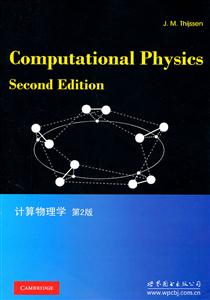-
>
宇宙、量子和人类心灵
-
>
气候文明史
-
>
南极100天
-
>
考研数学专题练1200题
-
>
希格斯:“上帝粒子”的发明与发现
-
>
神农架叠层石:10多亿年前远古海洋微生物建造的大堡礁
-
>
声音简史
计算物理学-第2版 版权信息
- ISBN:9787510032905
- 条形码:9787510032905 ; 978-7-5100-3290-5
- 装帧:一般胶版纸
- 册数:暂无
- 重量:暂无
- 所属分类:>>
计算物理学-第2版 本书特色
蒂森编著的《计算物理学(英文版)(第2版)》是一部理论物理研究的计算方法的教程。新增加的部分包括,有限元方法,格点Boltzmann模拟,密度函数理论,量子分子动力学,Monte Carlo模拟和一维量子系统的对角化。书中囊括了了物理研究的很多不同方面和不同计算方法论。如Monte Carlo方法和分子模拟动力学以及各种电子结构方法论,偏微分方程解方法,格点规范理论。全书都在强调不同物理场中的方法之间的关系,内容较为简洁明快,具有基本编程,数值分析,场论以及凝聚态理论和统计物理的本科知识背景就可以完全读懂本书。不管是理论物理,计算物理还是实验物理专业的研究生还是科研人员,本书都相当有参考价值。目次:导论;具有球对称势的量子散射;Schrdinger方程的变分大法;Hartree-fock方法;密度函数理论;周期性固态Schr.dinger方程解法;经典平衡态统计力学;分子动力学模拟;量子分子动力学;Monte Carlo方法;变换矩阵和自旋链的对角化;量子Monte Carlo方法,偏微分方程的有限元方法,流体力学的Lattice Boltzmann方法,格点场论的计算方法;高效能计算和并行法;附:数值法;随机数发生器。
计算物理学-第2版 内容简介
This Second Edition has been fully updated. The wide range of topics covered inthe First Edition has been extended with new chapters on finite element methodsand lattice Boltzmann simulation. New sections have been added to the chapters ondensity functional theory, quantum molecular dynamics, Monte Carlo simulationand diagonalisation of one-dimensional quantum systems. The book covers many different areas of physics research and different computa-tional methodologies, with an emphasis on condensed matter physics and physicalchemistry. It includes computational methods such as Monte Carlo and moleculardynamics, various electronic structure methodologies, methods for solving par-tial differential equations, and lattice gauge theory. Throughout the book, therelations between the methods used in different fields of physics are emphas-ised. Several new programs are described and these can be downloaded fromwww.cambridge.org/9780521833462 The book requires a background in elementary programming, numerical analysisand field theory, as well as undergraduate knowledge of condensed matter theoryand statistical physics. It will be of interest to graduate students and researchers intheoretical, computational and experimental physics.Jos THIJSSEN is a lecturer at the Kavli Institute of Nanoscience at Delft Universityof Technology.
计算物理学-第2版 目录
- >
朝闻道
朝闻道
¥14.8¥23.8 - >
苦雨斋序跋文-周作人自编集
苦雨斋序跋文-周作人自编集
¥6.1¥16.0 - >
小考拉的故事-套装共3册
小考拉的故事-套装共3册
¥36.7¥68.0 - >
名家带你读鲁迅:朝花夕拾
名家带你读鲁迅:朝花夕拾
¥10.5¥21.0 - >
名家带你读鲁迅:故事新编
名家带你读鲁迅:故事新编
¥13.0¥26.0 - >
诗经-先民的歌唱
诗经-先民的歌唱
¥14.5¥39.8 - >
中国人在乌苏里边疆区:历史与人类学概述
中国人在乌苏里边疆区:历史与人类学概述
¥21.6¥48.0 - >
企鹅口袋书系列·伟大的思想20:论自然选择(英汉双语)
企鹅口袋书系列·伟大的思想20:论自然选择(英汉双语)
¥6.3¥14.0
-
世纪幽灵-走近量子纠缠
¥9.4¥28 -
物理学之美-插图珍藏版
¥29¥69 -
半导体物理学(第8版)
¥46.4¥59.8 -
冬吴相对论-附光盘
¥18.6¥49 -
空间域密度界面反演方法
¥38.4¥68 -
不良情绪应急处理包--孤独感
¥12.9¥30
金仓数据库 KINGBASEES SQL编程
¥56.3¥75.0当夏洛特被欺负的时候【绘本】/[法]阿梅丽·雅沃
¥35.3¥49.0名医聊百病疝病防治知多少
¥13.6¥37.0Levy噪音驱动的传染病模型的动力学行为
¥26.0¥48.0农村可再生能源发展机制研究:基于参与人视角的分析
¥20.7¥42.0

















